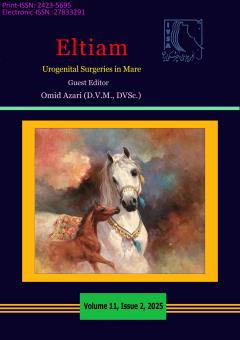A review of Antimicrobial Stewardship in Mares Urogenital Surgery: Current Practices and Evidence-Based Guidelines
Subject Areas : Veterinary Soft and Hard Tissue Surgeryخاطره کفشدوزان 1 , faeze Emarloo 2 , hamid reza moslemi 3
1 - 1. Associate Professor of Veterinary Pathobiology, Department of Pathobiology, Faculty of Veterinary Medicine, Semnan University, Semnan, Iran
2 - Department of clinical sciences, faculty of vet. medicine, semnan University
3 - 3. Associate Professor of Veterinary Surgery, Department of Clinical Sciences, Faculty of Veterinary Medicine, Semnan University, Semnan, Iran
Keywords: Urogenital, Antibiotics, Mare, Surgical Site Infections,
Abstract :
Background: A review of antibiotic therapy in urogenital surgeries of mares
Objective: a comprehensive guide on the selection of appropriate antibiotics, reviewing common bacteria involved in urogenital infections in horses and examining commonly used antibiotics
Methods: Data collection has been documented based on the review of previous studies
Results: Given the significant role of the equine breeding industry in various countries and its considerable impact on the development of diverse economic sectors, addressing issues related to the health and welfare of horses has become one of the primary priorities in this field. Among these concerns, the health of the mare’s urogenital system holds particular importance due to its critical role in reproduction and fertility. Despite notable advancements in surgical techniques, skin disinfection, and sterilization methods, surgical site infections remain a major challenge in equine health management. Strict adherence to sterilization protocols and the judicious use of broad-spectrum antibiotics are key strategies for preventing these complications. However, the overuse and misuse of antibiotics have led to the emergence of antibiotic resistance, which has become one of the most significant global challenges in veterinary medicine. Although the preventive use of antibiotics in equine urogenital surgeries is common practice, managing this use scientifically and rationally is essential to prevent the spread of antibiotic resistance. Therefore, this study aims to provide a comprehensive guide on the selection of appropriate antibiotics by reviewing common bacteria involved in urogenital infections in horses and examining commonly used antibiotics. It is hoped that the implementation of the recommendations provided in this review by veterinarians will contribute significantly to reducing the spread of antibiotic resistance.
Conclusions:
This review emphasizes the critical role of prudent antibiotic use in managing urogenital surgeries in mares, given the rising global challenge of antimicrobial resistance. By synthesizing data on common pathogens and effective antibiotics, it provides a science-based guide to optimize antibiotic selection and stewardship. Implementing these strategies can empower veterinarians to reduce surgical infections while mitigating the spread of antibiotic resistance in equine practice.
